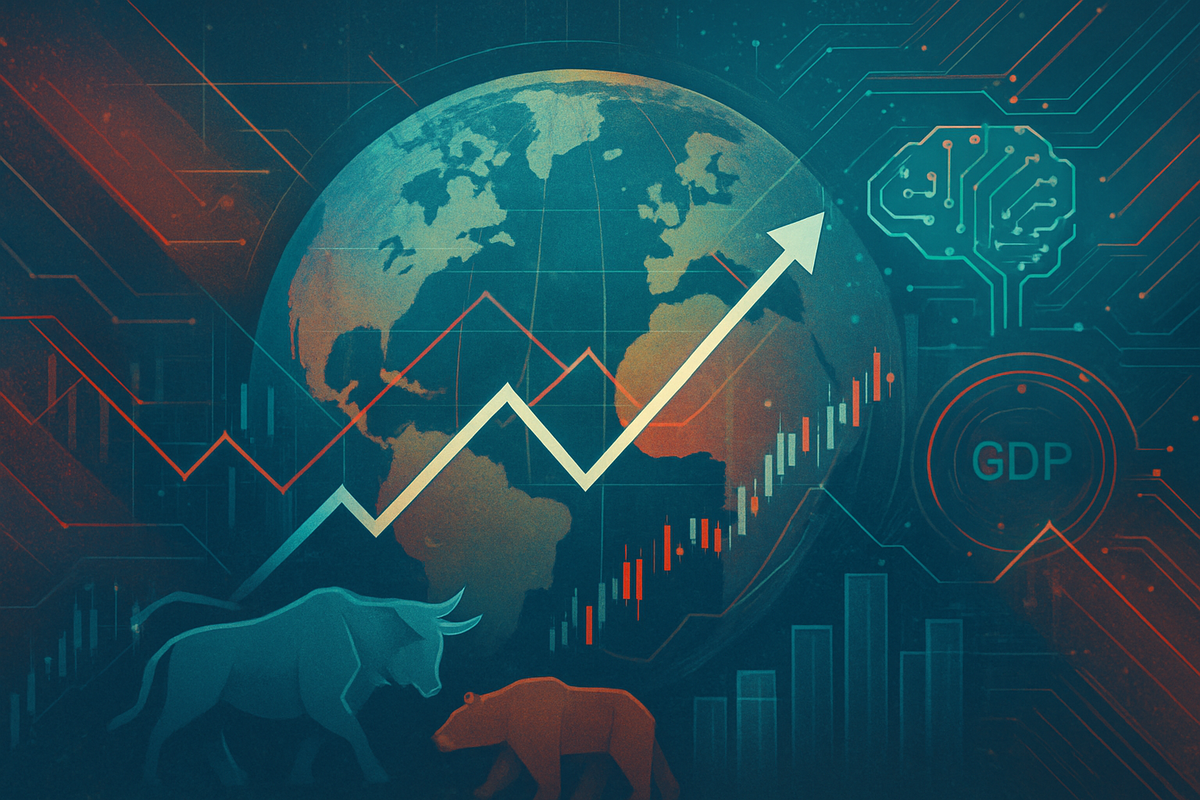
As of late October 2025, the global economic landscape presents a dichotomy of subdued growth and persistent uncertainties, juxtaposed with remarkably resilient, and in some cases, surging stock markets. While the International Monetary Fund (IMF) and other forecasters project a continued moderation in global growth, central banks worldwide are increasingly leaning towards or actively implementing monetary easing, a move largely seen as a tailwind for risk assets. This complex environment is further complicated by escalating geopolitical tensions, particularly between the US and China, which are reshaping trade flows and commodity markets.
Despite these headwinds, major stock indices, notably in the United States, have been hitting record highs. This bullish sentiment is primarily fueled by optimistic expectations for further interest rate cuts from central banks like the US Federal Reserve and the Bank of Canada, coupled with stellar performance from technology and artificial intelligence sectors. Investors, however, remain vigilant, balancing the promise of lower borrowing costs and innovative growth against the specter of persistent inflation, geopolitical instability, and potential overvaluation in certain market segments.
Navigating a Complex Economic Tapestry: Details and Market Reactions
The global economy in October 2025 is defined by a delicate balance of moderating growth, varied inflation trajectories, and a significant pivot in monetary policy, all set against a backdrop of evolving trade dynamics and the pervasive influence of artificial intelligence. International organizations generally anticipate a subdued growth path, while central banks are embarking on easing cycles, albeit with careful consideration of regional inflation differences.
Global GDP growth is projected to slow, with the IMF forecasting a deceleration to 3.2% in 2025 and 3.1% in 2026. Advanced economies are expected to see around 1.5% growth, while emerging markets are projected slightly above 4%. The United States (US) showed resilience with Q2 2025 GDP growth revised to 3.8%, though a near-term moderation is expected. China's growth has slowed to 4.2% in Q2 2025, grappling with real estate challenges and trade impacts. Inflation, while generally declining globally, remains a concern in the US, reaching 2.9% in August 2025, above the Federal Reserve's (Fed) 2% target. The Eurozone's inflation held steady at 2%, while the United Kingdom (UK) faced more persistent inflation at 3.8%.
A significant shift in monetary policy occurred in Q3 and early Q4 2025. The US Federal Reserve initiated a rate-cutting cycle in September 2025, reducing rates by 25 basis points to a range of 4%-4.25%, with further cuts anticipated in October and December. This move signals a policy shift towards economic support amid a weakening job market. The European Central Bank (ECB) maintained its main policy rate at 2%, while the Bank of England (BoE) held rates at 4% due to inflation and weak growth. The Bank of Canada (BoC) also cut rates by 25 basis points in September. Geopolitical tensions, notably renewed US-China trade disputes and ongoing conflicts, continue to weigh on global stability and trade.
Market reactions have been largely positive, particularly in equity markets. Global stock markets experienced a strong rally in Q3 2025, fueled by enthusiasm for Artificial Intelligence (AI) and the Fed's pivot to rate cuts. The S&P 500 (INDEXSP: .INX) gained over 8% in Q3, hitting new highs, with technology stocks as key drivers. Bond markets found support, with the 10-year Treasury yield declining. However, elevated valuations, especially in mega-cap tech stocks, raise concerns about potential corrections. The US dollar has shown signs of weakening, intensifying discussions around "de-dollarization," while commodity prices, including oil and gold, have seen some easing.
Corporate Fortunes: Winners and Losers in a Shifting Landscape
The current global economic outlook, shaped by subdued growth, varying inflation, anticipated interest rate cuts, geopolitical friction, and the AI boom, is creating distinct winners and losers across public companies and sectors. Agility and strategic positioning are proving paramount.
The Technology Sector, especially companies at the forefront of AI, is experiencing a significant boom. Lower interest rates reduce the cost of capital for these growth-oriented firms, further boosting their valuations. Companies like Nvidia (NASDAQ: NVDA), dominant in AI GPUs, and Taiwan Semiconductor Manufacturing Company (NYSE: TSM), a crucial chipmaker, are direct beneficiaries of the massive investments in AI infrastructure. Cloud giants such as Microsoft (NASDAQ: MSFT) and Alphabet (NASDAQ: GOOG) are integrating AI across their platforms, while Meta Platforms (NASDAQ: META) is heavily investing in generative AI. ASML (NASDAQ: ASML), the sole manufacturer of EUV lithography systems, holds a monopolistic advantage in advanced chip production.
Sectors sensitive to interest rates, such as Financials, Utilities, and Real Estate, are poised to benefit from anticipated rate cuts. Lower borrowing costs improve profitability for financial institutions, reduce debt service for utilities, and can stimulate demand in the real estate market. Regional banks, utility companies, and residential real estate developers could see improved performance. The Healthcare Technology (HCIT) sector is also seeing a boost from AI integration, with companies offering software and data analytics solutions for improved diagnosis and drug development. Furthermore, any easing of US-China trade tensions could benefit Shipping & Logistics firms like FedEx (NYSE: FDX) and UPS (NYSE: UPS), as well as major Retailers such as Walmart (NYSE: WMT) and Amazon (NASDAQ: AMZN), by lowering input costs and boosting trade volumes.
Conversely, several sectors face significant headwinds. Traditional Manufacturing and industries reliant on repetitive tasks are vulnerable to AI automation, which is leading to job displacement and efficiency gains for early adopters, but disruption for those slow to adapt. US Agricultural Exporters are particularly exposed to renewed US-China trade tensions, as tariffs could lead to lost export earnings, with the soybean sector being highly vulnerable. Companies with China-dependent supply chains and limited local presence are also facing pressure to diversify operations outside China due to tariffs and declining economic optimism. The Energy Sector, particularly oil and gas producers, could face volatility from geopolitical tensions and declining oil prices projected through 2026, driven by rising global production and potentially lower demand. Finally, while the broader real estate market may benefit from rate cuts, certain segments like Commercial Real Estate (office spaces) may continue to struggle due to shifts in work patterns and lingering valuation challenges.
Wider Implications: Reshaping Global Commerce and Policy
The current global economic outlook, characterized by subdued growth, persistent inflation, central bank easing, geopolitical rifts, and the AI revolution, carries profound wider implications, reshaping industries, international relations, and policy frameworks. This complex interplay signifies a "new normal" for the global economy.
These conditions align with broader industry trends, including the accelerating digital economy and technological innovation, where AI is a primary driver, yet also creates disparities due to concentrated investment. The restructuring of global commerce and supply chains is intensifying as protectionism and geopolitical fragmentation compel businesses to regionalize trade flows and diversify sourcing. Concurrently, the move toward a sustainable green economy remains a critical trend, with ongoing investments in green technologies, although geopolitical and economic pressures can influence policy commitments.
The ripple effects are substantial. Subdued growth and persistent inflation imply reduced demand for exports and increased input costs globally, particularly impacting emerging markets. Trade protectionism, especially US tariffs, raises production costs and disrupts supply chains, potentially benefiting countries like Mexico and Vietnam as trade is diverted. While interest rate cuts aim to stimulate activity, they also signal underlying economic weakness, and divergent monetary policies could lead to currency volatility. The concentrated growth in the AI sector creates a "rich get richer" scenario for leading tech firms, but also poses a risk of an "AI bubble" that could trigger a rapid downshift in valuations, impacting technology-dependent regions.
Policymakers face a delicate balancing act. Central banks must carefully manage interest rate adjustments to control inflation while supporting economic activity. Governments are urged to restore fiscal confidence through sustainable policies amidst rising global public debt. In trade, efforts are needed to foster a predictable and transparent environment, countering protectionist tendencies. The rapid adoption of AI necessitates new regulatory frameworks to balance innovation with consumer protection and market stability, alongside policies to address potential job displacement and labor market shifts.
Historically, the current environment draws parallels with past economic challenges. The AI boom's exuberance and high valuations echo the dot-com bubble of 2000, and the massive AI infrastructure investments are likened to the railroad boom of the 1880s. The rise in protectionist trade policies, particularly US tariffs, is reminiscent of historical trade conflicts that often led to slower global growth. The persistent subdued growth and elevated uncertainty can be compared to periods following major economic shocks, while central banks navigating interest rate adjustments after significant hikes mirrors past monetary policy cycles, albeit with added complexities from global interconnectedness and geopolitical factors.
The Road Ahead: Navigating Opportunities and Challenges
As the global economy and stock markets move forward from late 2025, the path ahead is marked by both significant opportunities and persistent challenges, demanding strategic foresight from businesses and investors alike. The interplay of slowing growth, inflation dynamics, central bank actions, geopolitical shifts, and the AI revolution will define short-term volatility and long-term structural changes.
In the short term (next 6-12 months), global growth is expected to remain subdued, with some downside risks. The fading of temporary economic boosters from early 2025 will contribute to this moderation. Interest rate cuts from the US Federal Reserve are anticipated to continue, aiming to support economic activity amidst a softening labor market. However, stubborn inflation in some economies may lead central banks to proceed cautiously. Stock markets, while currently riding an AI-fueled rally, face macroeconomic headwinds such as slowing consumption. The concentration of market capitalization in a few AI mega-caps presents a vulnerability if their growth expectations are not met. Geopolitical events and trade negotiations will remain critical wildcards.
Looking to the long term (beyond 12 months), global growth is projected to remain moderate, with the IMF's five-year forecast at its lowest in decades (3.1%), reflecting ongoing challenges like trade barriers. However, the AI boom is expected to be a long-term structural shift, continuing to power global expansion and redefining economic growth. Analysts anticipate annual AI infrastructure spending to climb by over 30%, driving demand across chips, energy, construction, and shipping, potentially preventing a significant recession in 2026. Inflation is generally expected to decline towards central bank targets, though unevenly. Geopolitical risks, including economic fragmentation and protectionism, are expected to persist, reshaping currency and commodity markets and introducing new uncertainties.
For businesses, strategic pivots are essential. This includes enhancing supply chain resilience and diversification to mitigate geopolitical risks, and aggressively integrating AI technologies to boost productivity and unlock new markets. Adaptability to evolving trade policies and regulatory environments, particularly concerning AI, is also crucial. For investors, diversification across asset classes, geographies, and sectors is key to managing volatility. While AI mega-caps offer growth, careful valuation assessment and consideration of undervalued sectors like real estate and healthcare are advised. Emerging markets present compelling long-term opportunities due to superior growth prospects and technological advancement, despite higher political volatility. Risk management, including currency hedging, and a long-term investment perspective focusing on fundamental strength, are vital.
Potential scenarios range from a "soft landing," where effective monetary policy and AI-driven productivity avert a deep recession, to a "stagflationary tilt" with slowing growth and rising inflation. A "prolonged subdued growth" scenario with elevated debt and regional crises is also plausible. Conversely, a "geopolitical escalation" could trigger a sharper global slowdown and market declines. The most optimistic "AI supercharge" scenario envisions AI exceeding expectations, driving unprecedented productivity and robust economic growth, pushing stock valuations even higher.
A New Era of Financial Navigation: Wrap-up and Investor Outlook
As of late October 2025, the global financial landscape is navigating a period of profound transition, marked by a delicate equilibrium between moderating economic expansion, persistent inflationary pressures, a pivotal shift in central bank policies, enduring geopolitical complexities, and the transformative, yet speculative, ascent of artificial intelligence. This confluence of forces demands a nuanced understanding and a strategic approach from market participants.
Key takeaways reveal a global economy experiencing subdued growth, with projections for 2025 and 2026 indicating a continued slowdown. Inflation, while generally declining, remains above target in the US, fueled partly by tariffs, contrasting with more benign environments in some emerging markets. Central banks, led by the US Federal Reserve, are embarking on an easing cycle, cutting interest rates to support economic activity, though the Fed itself signals a more cautious pace than market expectations. Geopolitical tensions, particularly the US-China rivalry, continue to shape trade and supply chains, though a recent temporary de-escalation in tariffs provided immediate market relief. The AI boom remains a powerful market driver, pushing US indices to new records, but also raising concerns about an "AI-fueled stock market bubble" due to concentrated valuations and potential overexuberance.
Assessing the market moving forward, continued volatility is highly probable. The current "risk-on" sentiment, buoyed by anticipated rate cuts and temporary geopolitical calm, could sustain equity gains in the short term, especially for technology and growth stocks. However, this optimism is tempered by significant downside risks: a potential divergence between market and central bank expectations for rate cuts, the fragility of AI sector valuations, and ongoing fiscal vulnerabilities. The market will likely remain sensitive to economic data and policy shifts, with a watchful eye on any resurgence of trade tensions or geopolitical instability.
The significance and lasting impact of this period will be defined by a "new normal" of elevated uncertainty and structural shifts. Geopolitical realignments will likely lead to enduring changes in global trade and investment patterns. The AI revolution, irrespective of short-term speculative dynamics, is undeniably driving a fundamental re-allocation of capital and accelerating technological transformation across all industries, with lasting effects on productivity, market concentration, and new economic risks. Central banks' ongoing efforts to balance inflation control with growth support will shape interest rate trajectories for years, influencing everything from corporate borrowing to consumer spending.
For investors in the coming months, vigilance and adaptability are paramount. Closely monitor central bank communications for signals on interest rate adjustments, as deviations from market expectations can trigger significant shifts. Track inflation trajectories, particularly in the US, as persistent pressures could limit monetary easing. Stay informed on geopolitical developments, especially US-China trade relations, as these can rapidly alter market sentiment. Critically scrutinize AI sector valuations; while growth opportunities are compelling, overstretched valuations warrant caution and a diversified approach within the tech sector. Overall, diversification across asset classes, geographies (including emerging markets), and sectors remains crucial. A focus on companies with strong fundamentals and sustainable business models will be key to navigating potential volatility and capitalizing on long-term growth trends.
This content is intended for informational purposes only and is not financial advice






